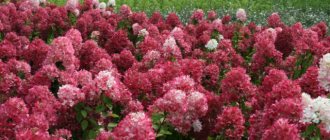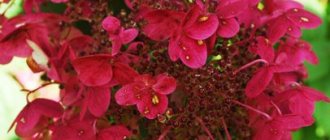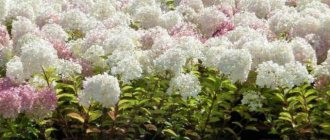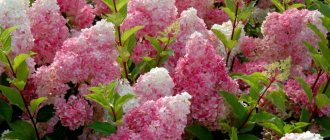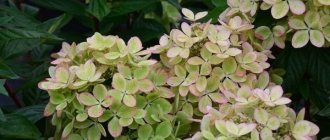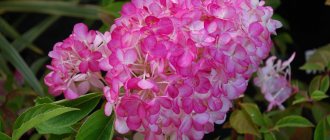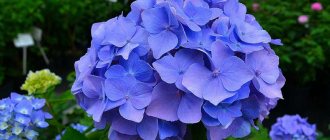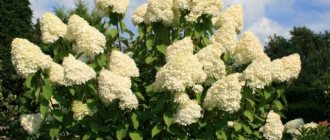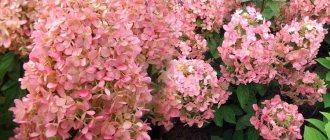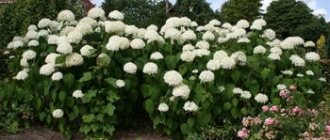Hydrangea paniculata is one of the largest species of shrubs, growing in strong and dense branches. Among hydrangeas, there are also multi-stemmed trees reaching a height of 10 m, but most varieties stop growing when they reach 1.5-3 meters. The plant received its name from the princess of the Holy Roman Empire, Hortense. This plant appeared in Europe at the end of the 18th century. It was brought by the English botanist J. Banks from Japan, and already in the 20th century, gardeners began to actively breed hydrangea varieties; by the middle of the century there were already about 100 of them.
Paniculate hydrangea in the garden differs from equally popular tree-like varieties mainly in the shape of the inflorescences: they resemble a wide pyramid. Inflorescences, as a rule, consist of small and large flowers. Moreover, during flowering they gradually change their color.
Hydrangea is an absolute favorite when it comes to decorating a summer cottage with flowers. For example, in Japan, hydrangea is considered a miracle of nature; residents poetically call it the flower of the purple sun.
General information on care requirements
- Flowering: from mid-June to October from four to five years of age.
- Planting: in spring before buds ripen or in autumn.
- Lighting: bright light or partial shade.
- Soil: fertile, neutral, without any admixture of lime or other alkalis, clay soils or red soil are preferred.
- Watering: abundant and regular, the soil at the base of the rhizome should be moist all the time.
- Fertilizers: fertilizers are applied 4 times per season: in early spring - organic matter with a high nitrogen content, during budding and in mid-summer - full mineral fertilizer, and in autumn - potassium-phosphorus fertilizer.
- Pruning: sanitary and formative pruning is often carried out, and, if necessary, rejuvenating pruning, at the end of March.
- Reproduction: most often by layering and cuttings, less often by seeds.
- Pests: aphids, spider mites, root-knot nematodes, snails.
- Diseases: white and gray rot, powdery mildew, peronospora, septoria, chlorosis, ring spot virus.
How to care for paniculate hydrangea?
In general, the plant is unpretentious. Grows well in environmentally unfavorable areas. It is not afraid of swampy and clayey soils. The shrub feels great in the shade and under the scorching rays of the sun. The bush is suitable for cultivation in any climate.
Increased frost resistance allows you to grow flowers in the conditions of the Russian north. Some varieties can withstand temperatures down to -30 degrees.
Getting ready to land
Planting hydrangea paniculata, as well as subsequent care for it, does not require special skills. The shrub grows quickly and begins to bloom within 2-3 years. But you should still familiarize yourself with the basic rules in order to properly plant hydrangea in open ground. These include:
- Landing place. Choose areas that are protected from strong winds and have good lighting. It should be borne in mind that it blooms best in partial shade, that is, it will be great if a shrub or tree grows nearby. It is best to plant on the east side of the garden.
- Hydrangea planting dates. In cold climates, seedlings should be planted in early May, in the southern regions - in September.
- Soil and acidity. Hydrangea grows very well in fertile and clay soils that are rich in humus. It grows worse on red soils. Sandy soils are completely contraindicated. The optimal acidity indicator is pH 5.3-6.0. That is, the soil should be slightly acidic, this way you can ensure maximum brightness of the inflorescences. On neutral soil, the inflorescences are pale in color, and the bush grows slowly.
- Purchase of seedlings. Give preference to seedlings only with a closed root system, as they are less likely to be susceptible to any diseases. Seedlings can be bought at garden stores and flower fairs.
You may be interested in: Pinky-Winky hydrangea. Planting and care, description of the variety.
Varietal diversity
The hydrangea shrub has many species, the total number of which, including the most popular varieties, has long passed the hundred mark. The absolute favorites, which do not require endless care, are the least demanding varieties of hydrangea:
- Hydrangea paniculata;
- hydrangea;
- large-leaved hydrangea.
Garden paniculata hydrangea, photos of its species and varieties are presented below:
Autumn and spring activities in the garden
In the spring, before the sap begins to flow, it is necessary to properly prune. On paniculate varieties, only last year's shoots are removed, without affecting the new growth, since inflorescences will form only on it. If a gardener mistakenly removes this year's branches, flowering will not occur.
In the fall, shoots are also pruned, leaving 2 to 3 pairs of buds. Next year, many new inflorescences will form from them.
Autumn activities include covering the bush for the winter and mulching the soil in the area of the roots. Preparations for winter are carried out from mid to late October:
- For small plants, all leaves are removed before covering.
- Soil is poured under the roots.
- For insulation, it is better to use spruce branches - spruce branches. The height of the spruce house should completely cover the top of the tree.
- Covering fabric is placed on top and pressed against the edges with stones to prevent it from being blown away by the wind in winter.
The advantage of such a shelter is that it retains heat, but allows the bush to breathe. In the spring, as the air warms up, you can gradually open the material, accustoming the plant to fresh air.
Higher crops are covered under a house made of long sticks, then covered with lutrasil. The roots are mulched with sawdust, humus, straw or peat. In spring, mulch from humus or peat can be dug up with the top layer of soil, providing the plant with nutrition for the growing season. The breakdown of organic matter can be helped by the bacteria preparation Baikal or Shining.
Reproduction
Hydrangea propagation can be done in the following ways:
- Seeds.
- By cuttings.
- By layering.
- Offspring.
Let's take a quick look at each of the methods:
- Hydrangea seeds do not require pre-sowing preparation, so they can be sown immediately in seedling boxes. Seeds should not be planted in the soil. Immediately after sowing, cover the box with glass or plastic wrap. At the same time, of course, do not forget that the soil must be moist. We are waiting for the sprouts and carrying out further planting in the ground. Planting paniculata hydrangea in open ground from an indoor pot in the summer is done in the same way.
- The simplest and most successful method of propagation is cuttings. In most cases, semi-lignified cuttings are used for this purpose, and summer is considered the most successful time for cuttings. However, you can also cut paniculate hydrangea in spring and autumn - only in this case woody cuttings are used.
- Many gardeners propagate hydrangea by layering, but this method is relatively unproductive. To do this, you need to bend the young outer flexible branches from the growing bush and pin them to the ground (in a hole 15 cm deep) with brackets, tying the ends of the branches to pegs.
- Offshoots or children are side shoots that the plant sends out from the buds near the root collar. They are in the ground, so they quickly grow roots. Their upper part sprouts near the mother bush and soon turns into a young plant. The offspring that appeared this year can be separated from the adult bush in the fall before the onset of frost. But they are not planted in open ground, but grown in pots and only planted in a permanent place in the spring.
In all of the above cases, when planting in the ground (except for seed propagation), at the very bottom of the hole, on the underside of the shoot, you must first make an oblique cut several centimeters long and insert a match into the cut. This tissue damage will accelerate the formation of roots in this area. All that remains is to sprinkle the bases of the shoots with a light mixture of soil and peat, regularly moistening the soil.
How to prepare hydrangea for winter in autumn
Preparing hydrangeas for winter is a very simple task. There are many recommendations on the Internet that almost no one will follow. It's actually not that complicated. All that needs to be protected from the plant are the roots from freezing, and the branches so that they are not broken by the mass of snow.
The roots can freeze because they lie near the surface of the soil, so the best option to protect them is to mulch with a 10-centimeter layer of pine litter, sawdust, and humus.
This simple measure will help prevent the soil from freezing and at the same time acidify it. If you are afraid that the branches will freeze, then you will still trim them in the spring, since hydrangea blooms on the shoots of the current year and last year’s ones must be pruned.
To prevent branches from being broken by snow, they must be trimmed and all foliage removed. It is advisable to tie the bush with a rope so that it does not fall apart.
If your bush is young and you are covering it, then try to do it as close to the ground as possible so that the bush is additionally covered with snow. Panicle hydrangeas do not require any other shelters; their winter hardiness is quite high.
Hydrangea paniculata: planting and care in open ground
Flower seedlings are planted just before the buds are set. 2-4 weeks before planting, completely clear the area of plant debris and dig up with a shovel. It is very important to choose the right place for the seedling on the site. Some varieties grow well in partial shade, while others need plenty of sun.
Paniculata hydrangea is planted in open ground in early spring or September. It is still advisable to buy paniculata hydrangea in the spring, then it will take root very quickly and begin to actively grow.
If individual bushes are planned, then when planting hydrangeas, it is recommended to maintain a distance between seedlings of 1.2-1.4 m. This way, the root system of each bush will successfully grow and become stronger. To achieve early flowering, you can reduce the distance between seedlings to 0.7-0.8 m, and after a few years, thin out the overgrown bushes.
Next, prepare the soil mixture. The composition includes leaf and turf soil, peat and humus in equal quantities. The most important thing is to water the plant before planting; to do this, remove it from the container, untangle the roots as much as possible, trim them a little, and place the seedlings in a bucket of water for 5–6 hours. The roots need to be shortened a little before planting. On the plant itself, it is necessary to cut off the annual shoots and leave only 3-5 buds on them. And in what year does paniculata hydrangea bloom after the first planting? New flowers will appear next year.
A mixture of manure and bone meal or ready-made fertilizer for hydrangeas is added to holes prepared according to the size of the root system. For planting, 3-4 year old hydrangea seedlings are taken. Place the seedling on a hill of soil mixture at the required depth and carefully fill the hole. Caring for paniculata hydrangea in open ground is not at all difficult, because this shrub is very unpretentious. Grows everywhere except swamps and clean sand.
Lastly, compact the soil with your palms. Next, water the bush with 10 liters of warm, settled water and mulch. Sawdust, bark or peat work well as mulch. Replanting paniculate hydrangea is necessary if the soil and planting site are initially selected incorrectly. Under no circumstances should you add chalk, lime and wood ash.
Arrangement of shrubs in the garden
Fans of paniculata hydrangea claim that growing this plant in their own area is quite simple; planting and caring for it do not require special skills. The bush grows quite quickly, inflorescences are born on the shoots already in the first year after planting (at most, in the second year). But you should not plant it close to stone walls and fences; such proximity leads to freezing of the bush in winter.
It is best to plant hydrangea in such a way that it is in partial shade during the midday hours. The plant will not be very comfortable under bright sunlight. In such conditions, hydrangea blooms later, and the flowering itself is not the most magnificent. Ideally, the plant will be illuminated by the sun only in the morning or evening hours.
When to plant paniculata hydrangea in open ground? In the early warm autumn in the garden, choose a site protected from the wind for hydrangea. This shrub tolerates cold well, but if a strong draft is added to the frost, branches and flower buds may freeze.
One of the main activities for any gardener is planting in a certain place, choosing the right location where the plant will feel comfortable for a long time. Many people wonder where to plant paniculata hydrangea, in the shade or in the sun? Many of the species grow and bloom well even in the shade, but hydrangea paniculata is best suited to sunny areas of the garden. Here it will grow, dominate and attract attention. In the shade, the plant does not fully reveal its beauty; its flowers lose their richness.
The plant prefers fertile clay or loamy soil. Does not develop in sandy soil. The soil for growing paniculata hydrangea should be acidic, so the flowering will be abundant and the color of the flowers will be bright. You can acidify the soil by first adding half-rotted pine needles, sawdust, and brown peat to it.
Watering
Hydrangea is a very moisture-loving plant. Basic care for a hydrangea bush should begin with proper watering; it is best to use warm water that has previously settled. This bush does not tolerate drought very well, watering must be regular, and the soil in the root zone must always be moistened, only drying the top layer is allowed, but nothing more.
Hydrangea paniculata, watering will require up to 30 liters. per square meter of soil around the bush. If the weather is rainy, volumes should be reduced. But the plant can do without watering; the hydrangea will not die in very dry seasons, but will look completely unattractive.
When watering, it is good to add potassium permanganate (potassium permanganate) to the water. You can also use citric or sulfuric acid by diluting a few spoons of it in water. It is advisable to regularly mulch the soil under the bush, adding leaves and sawdust, which will retain moisture in the ground. The acidity of water for irrigation is recommended no higher than 5.5-6 PH. But remember that with heavy watering, nutrients are washed away, and hydrangea is very demanding on nutrition (as we wrote about above).
Feeding and fertilizers
For active growth of hydrangea leaves, a large amount of nitrogen is required. The first feeding is aimed at the formation of healthy and strong leaves and is carried out from the moment the first buds begin to sprout, in March.
Caring for your paniculata hydrangea in summer also requires feeding; ready-made chemical compounds are used for this. In addition to them, you can add organic compounds. It can also be diluted slurry or a solution of bird droppings. But you should be careful with such nitrogen-containing fertilizers. An effective mixture in this case is urea and potassium sulfate. For 10 liters of water you need 1 tablespoon of each ingredient. Consumption – 5 liters per 1 bush.
In general, paniculata hydrangea requires frequent feeding. If this is not done, it grows poorly and does not bloom. 2-3 times a month you can water the bushes with fermented infusion of cow manure (about 3 liters of water per bucket of manure). For repeated watering, dilute 1 liter of infusion per bucket of water. This is a fertilizer for growing greenery.
How to speed up the abundant flowering of paniculata hydrangea
It is necessary to apply complex mineral fertilizers for flowering plants. Nitrogen not only activates the growth of green mass, but also increases the size of the inflorescences. With too much nitrogen, they can become too large and the branches begin to bend under the weight. This will not add decorative value to the bush.
At the beginning of the growing season (early spring), it is useful to apply the so-called green fertilizer (chopped young nettles diluted with water in a ratio of 1:10), but this method has not been conclusively confirmed.
Features of hydrangea
Hydrangea paniculata is a member of the Hydrangeaceae family and consists of many varieties. It grows in the form of a bush or tree, in some cases reaching 10 meters in height. Thanks to the efforts of breeders, varieties of this species are annually replenished with new worthy specimens.
Features of the paniculate type of hydrangea:
- delicate flowers, up to 3 cm in diameter, collected in lush fragrant inflorescences of elliptical shape;
- the color range of inflorescences varies depending on the variety - from snow-white to pale pink or light green;
- length of inflorescences - about 30 cm;
- width of inflorescences - up to 20 cm;
- branches are upright, spreading;
- leaves finely toothed, opposite.
In the second year after planting, hydrangea shoots become hard; after another 1 year, the plant is completely ready to flower. Until this point, all flowers from the seedling should be removed. The plant is frost-resistant, tolerates temperatures down to -26 °C. With proper care, it can live in one place for more than 50 years.
Problems of growing hydrangea paniculata
Growing, planting and caring for any paniculata hydrangea in the garden is associated with a lot of problems, since it is influenced by a lot of factors.
- The main problem with growing hydrangea is meeting soil acidity requirements. Acidity is determined by a special litmus paper or pH test. If the pH is greater than 6, then it is best to mulch the soil with pine needles. You can also add ammonium sulfate.
- Another threat to plants of this variety is direct sunlight, as well as drying out of the soil. As a result, the leaves quickly wither and flowering deteriorates.
- A small problem that you may encounter when growing paniculate hydrangea is that the branches are too thin, which can break under the weight of the inflorescences (especially if they are “overfed” with nitrogen). To cope with this problem, it is necessary to control the amount of fertilizer applied and, if necessary, trim flowers that are too heavy.
- If there is a lot of lime in the soil, the flower suffers from a lack of iron, which is necessary for normal life. In this case, you need to spill the soil with a solution of iron sulfate.
- The main thing is to monitor the condition of the leaves and the trunk itself after any application of the solution and fertilizing, since the cause of wilting of the bush may be incorrectly identified.
- If the ground under the bush gets very hot, in order to solve this problem, you just need to lay a peat cushion or wood chips.
- Another problem that can happen to paniculata hydrangeas is yellow leaves. But at the same time, the color of the veins remains unchanged. This means that the plants are suffering from chlorosis.
Varieties
We are sometimes asked to list the “names of paniculate hydrangeas”, the most popular in cultivation and at the same time the least capricious to care for, and are also asked to recommend varieties of paniculate hydrangea for the Moscow region. Actually, any variety of this species is winter-hardy enough for moderately frosty winters, but in conditions of abnormal cold, they all need shelter for the root zone.
- Marigold: growing and care in the garden
We offer you the best varieties of paniculata hydrangea.
Hydrangea paniculata Grandiflora (large-flowered)
A shrub that over time takes the form of a tree up to 3 m high. It is distinguished by later flowering than other varieties. Collected in wide pyramidal inflorescences up to 30 cm long, the large sterile flowers of this variety are creamy when blooming, pure white in full bloom, and then pinkish - becoming greenish-red closer to autumn. The lifespan of plants of this variety is about 30 years;
Hydrangea paniculata Vanilla Fraze
The plant is up to 150 cm high and has a crown of the same diameter. The inflorescences are large, similar to lilac clusters. The flowers are creamy at first, then they turn pink, and towards the end of flowering they become dark red. One bush can have snow-white and bright crimson flowers at the same time. Plants of this variety can withstand frosts down to -29 ºC;
Hydrangea paniculata Phantom
A plant up to 2 m high with a crown diameter of the same size. The inflorescences of this variety are large, dense, round-pyramidal. The flowers are light cream in color when opening, but become pinkish over time;
Hydrangea paniculata Pink Diamond
The inflorescences of this variety, up to 30 cm long, consist of creamy white flowers that gradually acquire a dark pink, almost red color;
Hydrangea paniculata Limelight
A plant extremely popular among designers due to its strong shoots that easily withstand heavy greenish inflorescences, which turn white in bright sun and pink towards the end of flowering. The leaves of this variety are green in spring and summer and turn purple in autumn;
Hydrangea paniculata Pink Lady
A fan-shaped shrub up to 2 m high with a spreading crown, straight brown shoots that acquire a reddish tint in autumn, and white inflorescences up to 30 cm long. Over time, a light blush appears on the fragrant white flowers, then the flowers gradually become soft pink;
Hydrangea paniculata Magical Candle
A plant with a spreading crown and large pyramidal inflorescences of light cream and green fragrant flowers, which turn pink in summer and crimson in autumn;
Hydrangea paniculata Vims Red
A plant with inflorescences up to 35 cm long, conical in shape, emitting a honey aroma. During the season, the flowers turn from white to pink, and at the end of flowering - deep red;
Hydrangea paniculata Diamond Rouge
A compact upright shrub with inflorescences up to 40 cm long, the flowers of which are initially white and then acquire a rich crimson-red color;
Hydrangea paniculata Sunday Fries
Dense compact bush with red-brown shoots, pubescent leaves along the veins and white flowers, which become lilac-pink by the end of summer;
Hydrangea paniculata Pinky Winky
A variety that was bred more than 10 years ago, but still has not lost its popularity. This is a small tree or bush with a wide-rounded crown and shoots that grow up to 30 cm annually. Powerful stems bear paniculate inflorescences of white flowers, which change color to pink-purple during the season;
Hydrangea paniculata Melba Fraze (Fraiz Melba)
A new variety, which is a tall bush with dark burgundy shoots with a brown tint and dense pyramidal inflorescences 45-55 cm long, consisting of milky white flowers, gradually acquiring at first a soft pink, and towards the end of flowering a rich wine-red hue.
In addition to those described, the following varieties of hydrangea paniculata are grown in culture: Silver Dollar, Little Lime, Kyushu, Bobo, Tardiva, Presox, Unique, Floribunda, Matilda, Darts Little Dot, Brussels Lace and others.
- Mimulus (lipstick): growing from seeds in the garden
